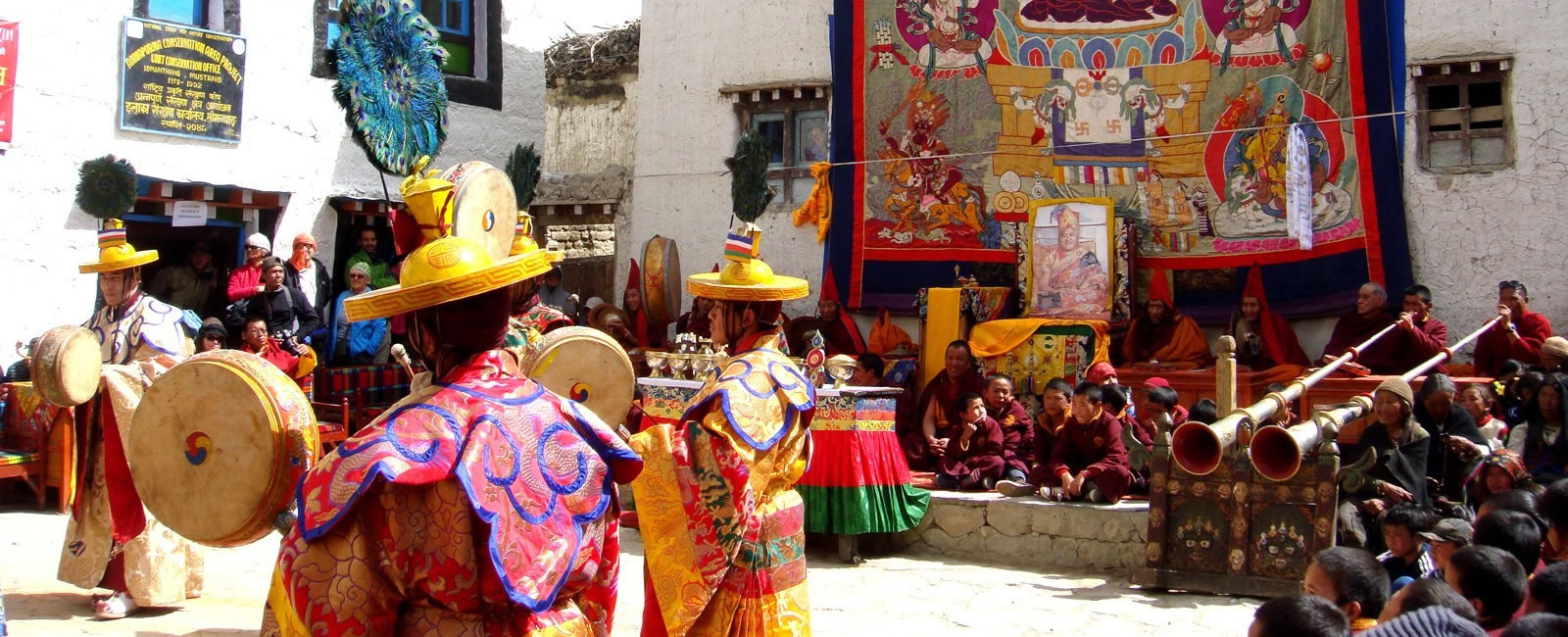
This is the most famous festival in Upper Mustang; it takes place every year in Lo Manthang. The festival has its origins in the Bon period but is a celebration of Guru Rinpoche, who is portrayed on a massive thangka in the main square outside the palace.
Guru Rinpoche was called to Tibet to appease and subjugate the local emon in the 8th century, protect Buddhism, and dispel misfortune, drought, and famine. The choreography of the current three-day festival apparently dates from around 1450.
Dances are performed by monks wearing colorful and often fearsome-looking masks. Sometimes the masks are not worn; whether or not they are worn is determined by astrologers, who decide if it is auspicious. Some dances are only performed every three years.
The colorful, exuberant dances are very spiritual; some are secretive in nature, with others representing, in a theatrical style, the monks' mediations to appease the demons. Some scholars have noted the similarities of these proceedings to some rituals in European cathedrals in the Middle Ages.
The festival has very similar traits to Mani Rimdu in the Everest region, held at Tengboche, and to others held to celebrate Losar (the Tibetan New Year). The Bon also have similar celebrations for their New Year, celebrated at Triten Norbutse near Swayambhunath.
At sunset, the thangka of Guru Rinpoche is hauled up to the sound of the drums and cymbals. Then, in a blaze of color and accompanied by evocative music, the first dance begins. This celebrates the ten divinities of Vajrakilaya, the fearsome-looking protector who banishes the enemies of compassion.
Prominent among the dancers in the Tsowo, a monk who has been in solitary retreat for months before the festival to practice the necessary mediation rituals.
It is said that the powers of Guru Rinpoche are transmitted to the Tsowo at the time of the festival. Thus, for the festival's duration, the Tsowo monk is the incarnation of Vajrakilaya (known as Dorje Jono in Mustang).
The main demon to be vanquished is, surprisingly, the father of Dorje Jono. It will take 52 dances to banish the demon. One dance used to be performed by the oracles, who acted under spells in a trance-like state.
This has been superseded by a dance where a masked dancer replaces the oracle (a sort of doctor/shaman). Oracles still perform in Ladakh at such festivals with similar dances. Humorous interludes and dances remind the throng that everything in this life is illusory and implement, so one should not take things too seriously.
The dances on the second day are more vigorous. A dagger pierces a straw effigy at the close of the day. On the third day, a dough effigy is also pierced with a dagger.
This curious ritual is part of the 'chasing away' of the bad spirits, negative actions, and bad karma of the town's citizens. The people's spirits are hidden within and represented by the strange straw effigy that normally sits above one of the streets.
The effigy is chased out of the town, and Dorje Jono shoots it with an arrow. Next, rocks are hurled at the image, and finally, a tiger skin is used to defeat the demon.
Previously, the king presides over the festival, but his duty will likely fall to his heirs with failing health.
In addition to the celebrations and drinking (to excess for a few!), a market bazaar is held outside the walls, offering traditional products such as wool, turquoise, embroidery, Chinese goods, and even horses and yaks.
Leave Your Comment